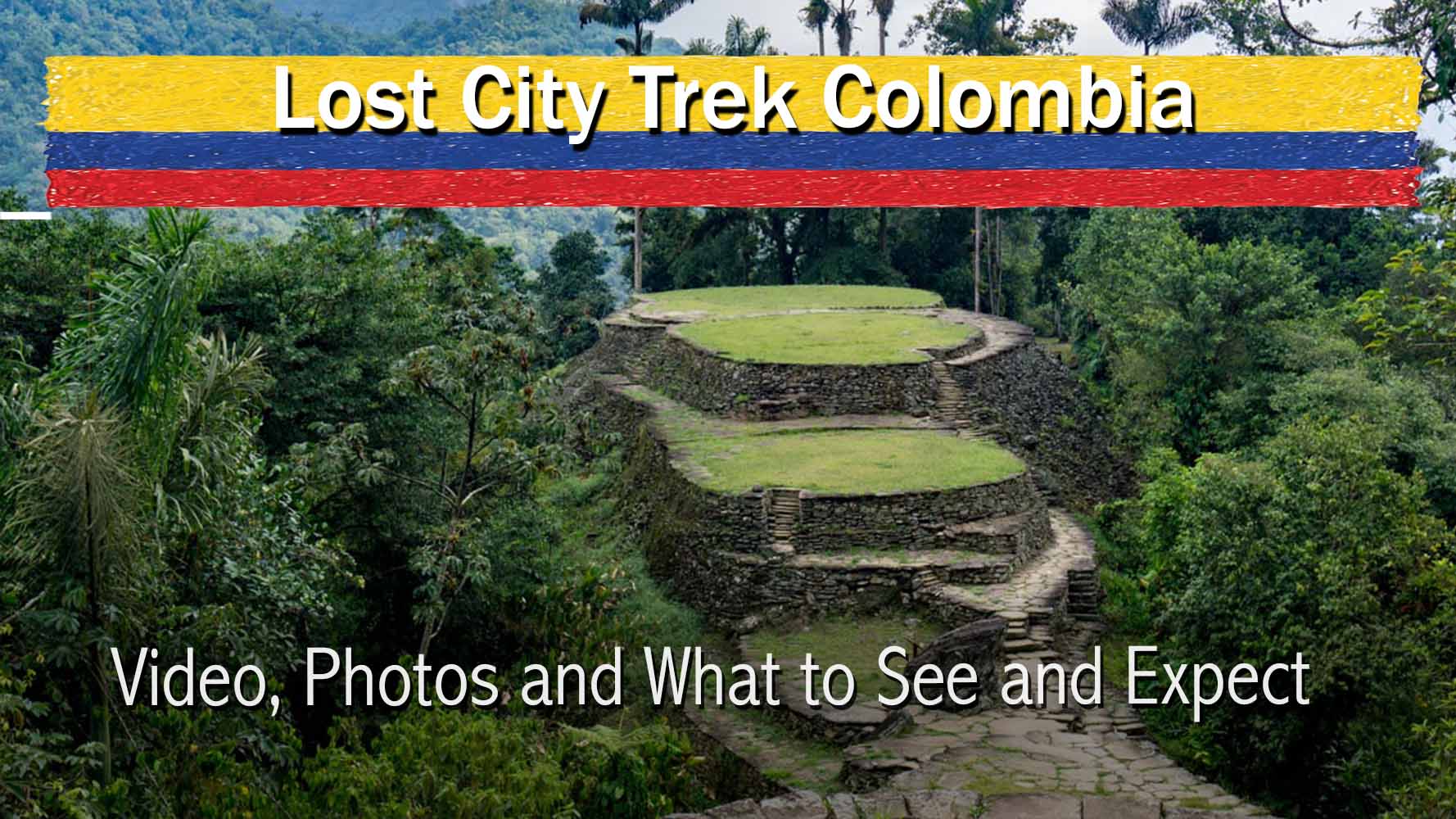Lost City Trek Colombia: Video, Photos and What to Expect
The Lost City Trek Colombia (also known as the Ciudad Perdida) is an incredible journey that takes you through diverse, ever-changing landscapes and scenery. The trip allows you to connect with the indigenous people as you get to see their local cultures and way of life. Moreover, it gives you a history lesson about the extinct Teyruna people.
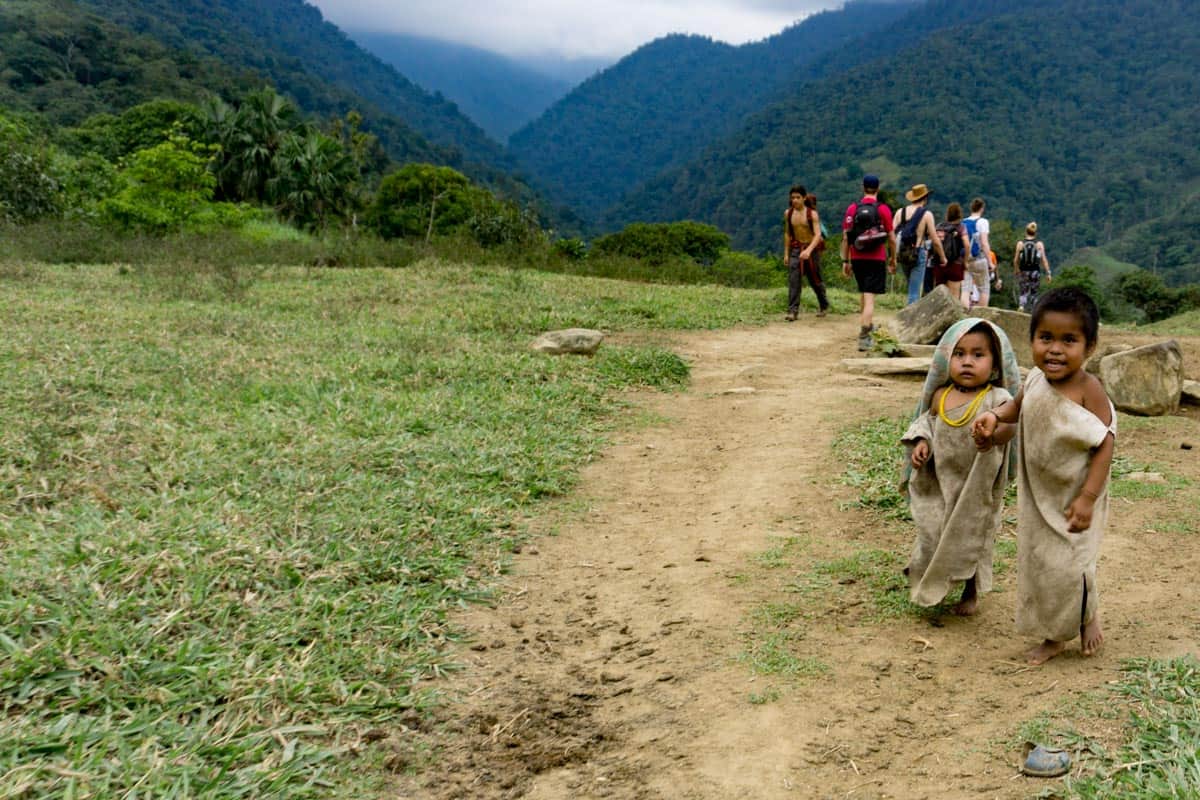
After four months of living in Colombia, we couldn’t wait to start the hike before we planned to leave the country three weeks later. We booked the trek with Impulse Immersive Travel Experiences
If you are traveling to Colombia and are still trying to figure out how to fit all the places of interest you want to visit, including this trek, within your timeframe, here are some sample itineraries that can help you organize your trip.
Probably, just like us, you want to prepare yourself for a hike, especially if it’s a commitment into the jungles of Colombia. When we had the opportunity to do the Ciudad Perdida trek, we needed more information to have a preview of what’s to come.
Our questions about the Lost City Trek Colombia included:
What would we see during our hike?
Or would this compare to the Inca Trail in Peru?
Should we be concerned about mosquitos and water?
Would it be worth doing the hike at all?
And how should we prepare for the hike, both physically and mentally?
What you need to know about the Lost City Trek Colombia:
1) Don’t compare Cuidad Perdida with Macchu Picchu as they are two different hiking experiences
One might think that two hikes to an ancient lost city in South America would be similar to one another. However, they are quite different. Although these hikes are both approximately 45km in distance and you “discover” the locality during your trek, the respective journeys are very distinct.
The Cuidad Perdida’s highlights are the dramatic scenic views and the transforming views of nature on your way to the lost city. The ruins are fascinating, along with the stories of the Teyruna people in Colombia, but it is the entire journey that takes the spotlight. Whereas the Inca trail, although it is a beautiful hike, is less diverse yet leads to the awe-inspiring ruins of Macchu Picchu. Interestingly, the Colombian ruins were only discovered in 1970 and were believed to have been built 600 years before the Inca Trail and Macchu Picchu in Peru, which was found in 1911.
The Lost City Trek Colombia begins at a lower altitude, so you don’t need to acclimatize before you start nor deal with the effects of altitude sickness. Its highest point, the Teyuna ruins, is 1,200m (3937 ft). The entire trek altitude is 900 meters to 1,200 meters. On the Inca Trail, the highest point (The Dead Woman’s Pass) is 4,200 m (13,800 ft). What a big difference!
The Lost City Colombia requires that you carry your own pack for the entire journey. Unlike in the Inca Trail, porters carry the majority of your belongings, and you are only required to carry items that you need for the day. So, planning appropriately for the Lost City trek Colombia is essential. (See below for packing recommendations.)
2) The diverse and dramatic landscapes are incredible
This is what is most magical about this trek – the landscape will change rapidly from the point when you start out your trek in the desert of the Sierra Nevada mountains. Then, it shifts quickly from lush green mountain vistas, limestone passages, flowing rivers, and endless jungles to rocky ravines and dark caves. It’s pretty spectacular!
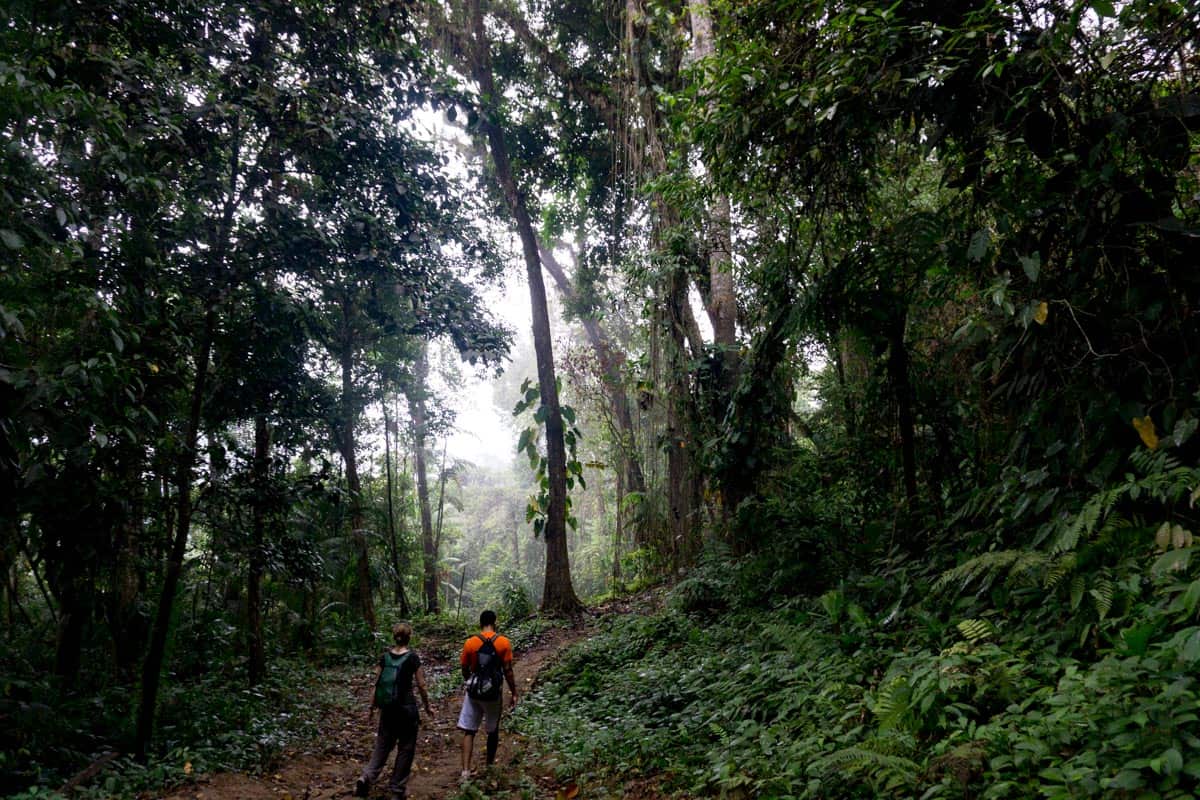
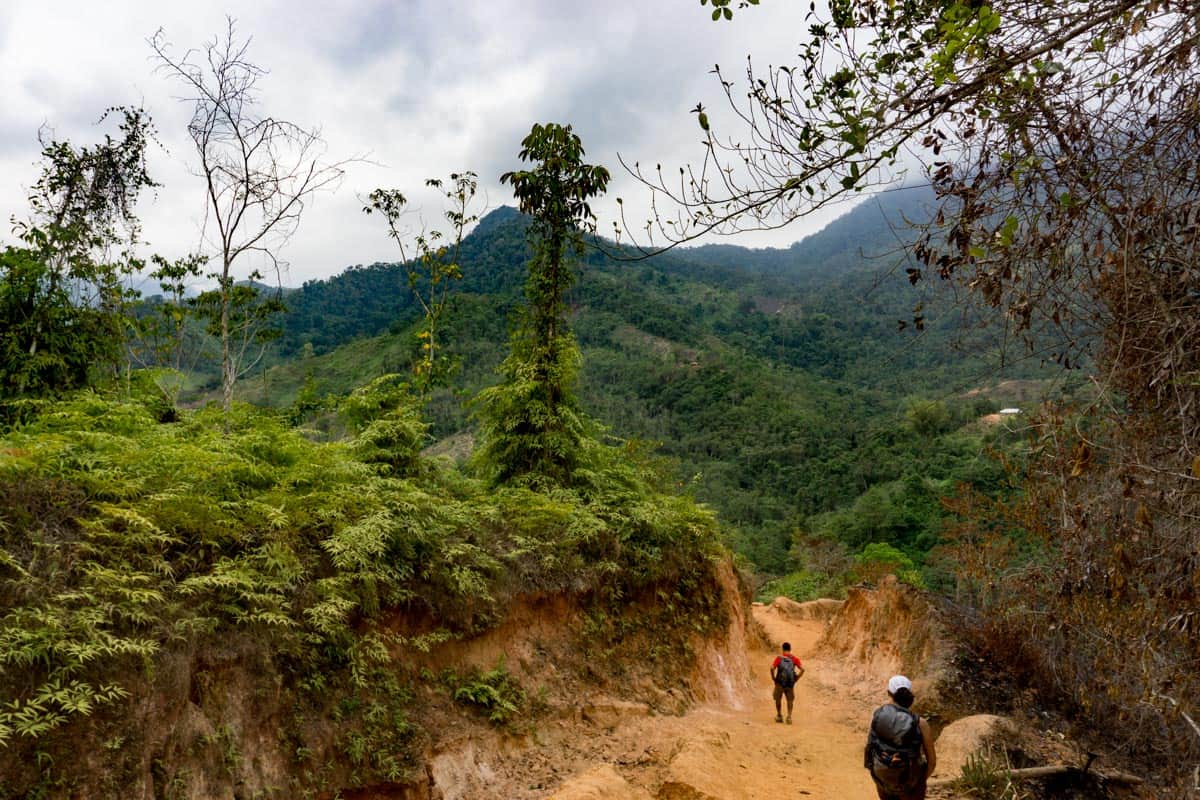
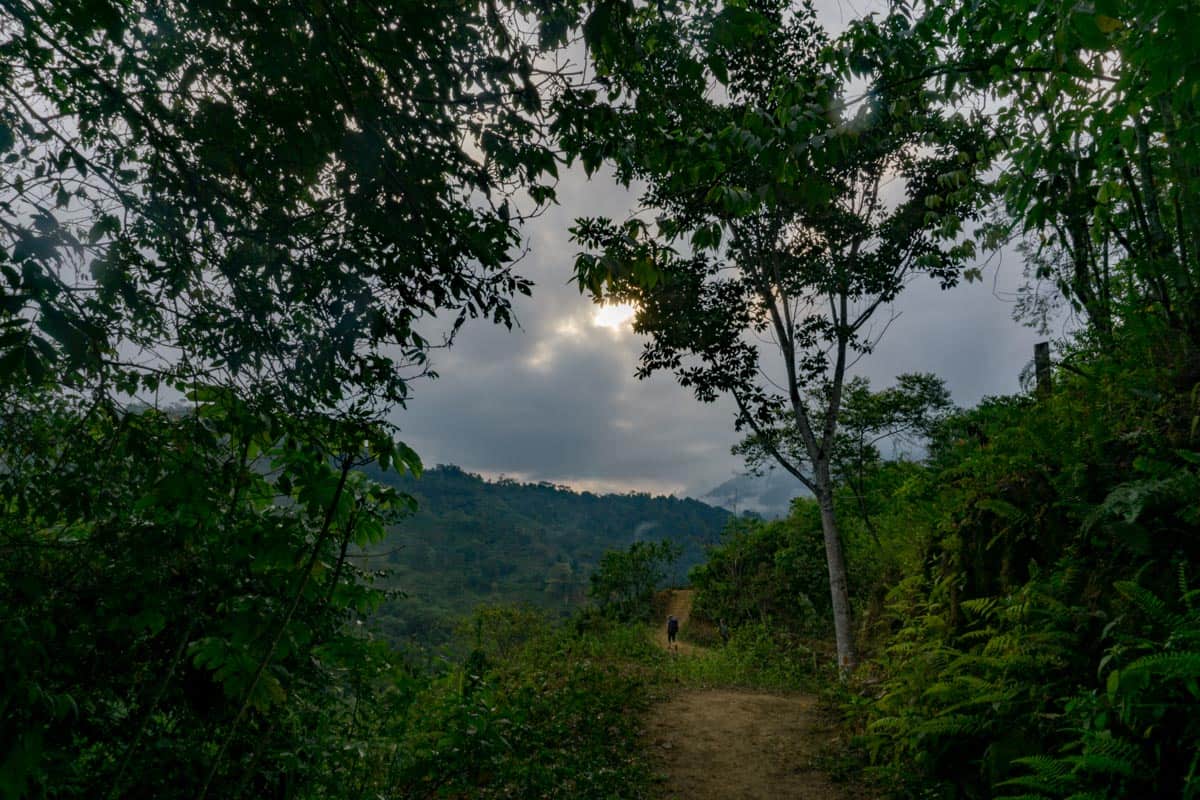
3) Learning about the traditional Indigenous tribes is an essential part of the hike
Throughout the Lost City Colombia Trek, you will meet many people from the indigenous tribes – descendants of the extinct Teyruna people. The Wiwa, Ika, Kogi, and Kankuamo tribes are those who live primarily in huts made of straw and dress in simple white tunics. They live so vastly different than us, or other indigenous groups around the world (especially in our home country of Canada), that it makes the trek so interesting.
Your journey even includes a special visit and talk with the spiritual leader of the Kogi, the Shaman, when you reach the ruins.
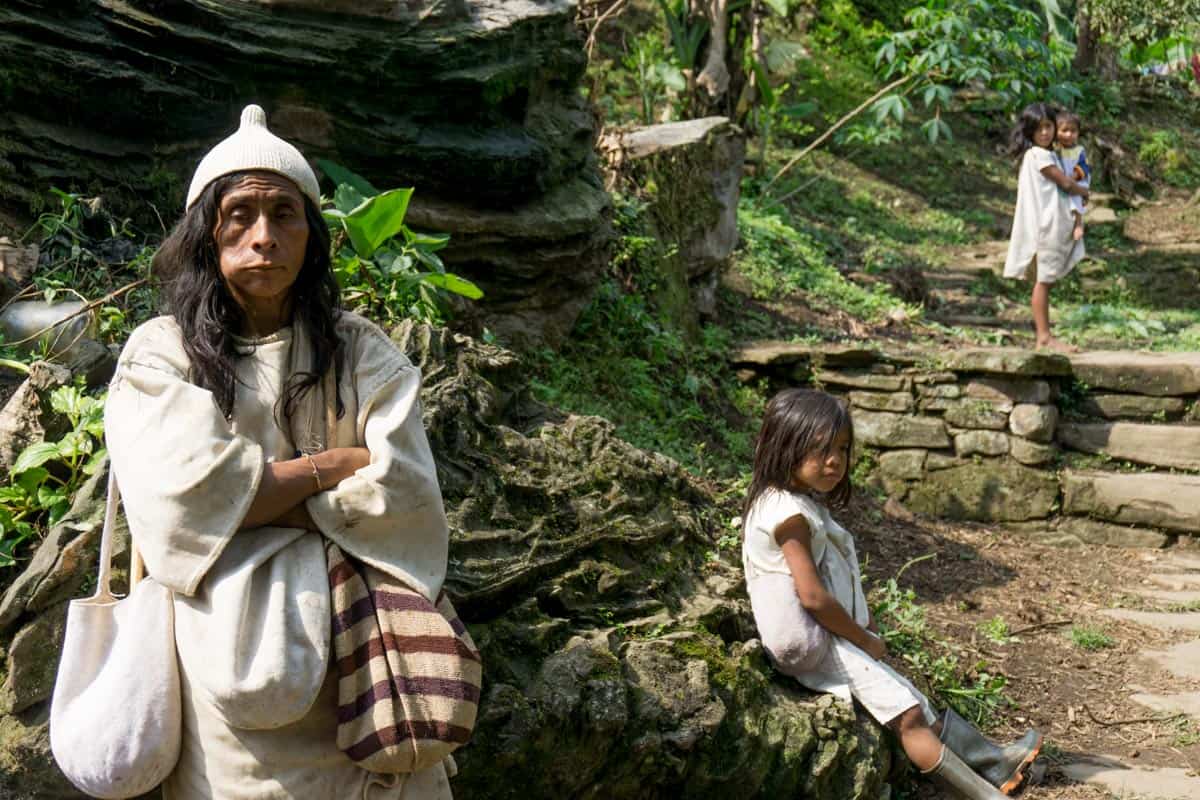
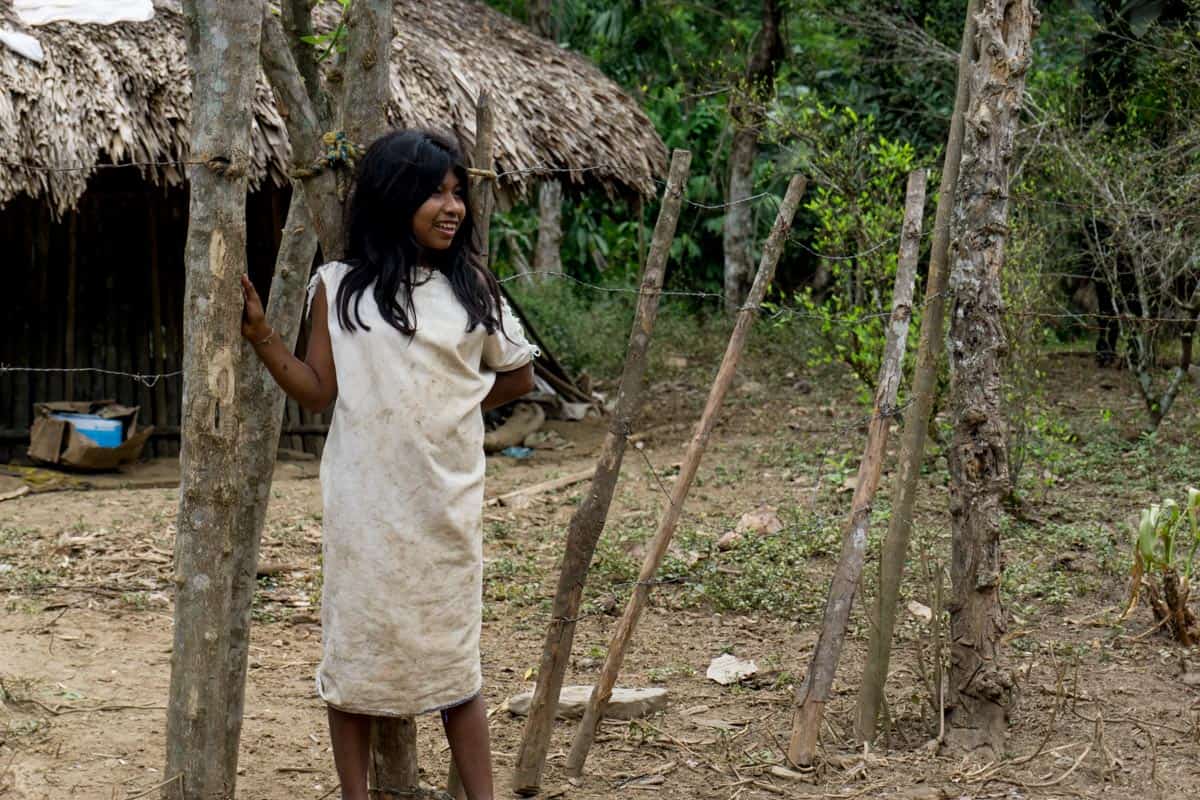
4) After, we recommend that you visit the Gold Museum in Bogotá to get a full appreciation for the Teyruna culture
FUN HISTORICAL TIP: If you have already visited the Gold Museum in Bogotá, or you plan to get to the city before you leave Colombia, there you will appreciate the vast collection of intricate gold ceremonial pieces and jewelry. Much of these artifacts were buried in the tombs under the homes and buildings of the Lost City. We went to the Gold museum before the trek, but after seeing the Lost City, we understood the significance of the artifacts and we were even more curious about the Teyruna people and their existence.
5) This is a challenging trek; you need to be in good physical condition
How Physically Fit do I need to be for the Lost City Trek Colombia?
If you are someone who gets regular cardio exercise, then this is a hike for you. We both wore our Fitbit watches, and on the display, below each day, you can see the level of terrain, inclines and walking during the trek.
How should I prepare myself mentally for this hike?:
Prepare yourself for heat, humidity, bugs, and mosquitos, including carrying your own backpack the entire way. This will require some mental resilience. Just be prepared, and know there is a relief during the trek as there are breaks that include cold wedges of pineapple and watermelon in every camp. There is a cold, refreshing waterhole where you can swim and wash off the sweat and bugs from the day.
Should I book the 4, 5, or 6-day hike?
You have a choice if you want to do the hike within four or five or six days, each at the same price of 700,000 COP ($233USD). Apparently, the price is set by the government, and it is consistent across all tour companies.
The standard trip length is 4 or 5 days. The only difference is a longer break on the third day. If you feel you may need some extra time, the five-day hike may be the one for you. We had some members in our group who took the five days and they discovered they just wanted to return immediately, as there are sufficient breaks already, so they came back earlier than expected.
Highlights of each day:
Day 1:
Hiking time: 3-4 hours Distance: 7 Kms
Here’s a graphical view from Troy’s Fitbit of how the hike looks regarding elevation and terrain.
(note the distance on the Fitbit recorded all the kilometers walked before and after the hike)

- Our trek was accompanied by our guide José, a second junior guide, who also doubled as our English translator and cook, who traveled ahead of us to get our meals ready for each camp.
- The trek started with a three-hour drive in a van or jeep from the tour office in Santa Marta to Machete Pelao. There, we had a very filling lunch (rice/salad, beans, and choice of chicken, pork, beef or fish) before we headed on with the hike.
- We stopped for two breaks each day to enjoy the views and eat chunks of watermelon, pineapple or oranges – these were delicious, energy replacement breaks!
- It is here where you will see amongst the green rolling hills several burnt out hills. They were once covered in Coca plants before they were burned down, and the guerrillas were forced out. Even years later, little vegetation grows in those areas.
- The terrain in the afternoon could change drastically, and the last stretch before we reached camp was filled with deep, red-colored ravines, surrounding us on our way down to the camp by the river.
- We arrived at the camp in mid-afternoon, but it might not be the case in other treks as the schedule is dependent on your pace while your camp location may also vary.
- Our camp was a set of several long tin-roofed buildings with living quarters on one end and wooden bunk beds draped with mosquito nets and dining quarters on the other. A large kitchen and several wooden tables with benches were located at the front. Other hiking groups from different companies also camped in other sections of the buildings. (Note that some camps have hammocks instead of bunkbeds.)
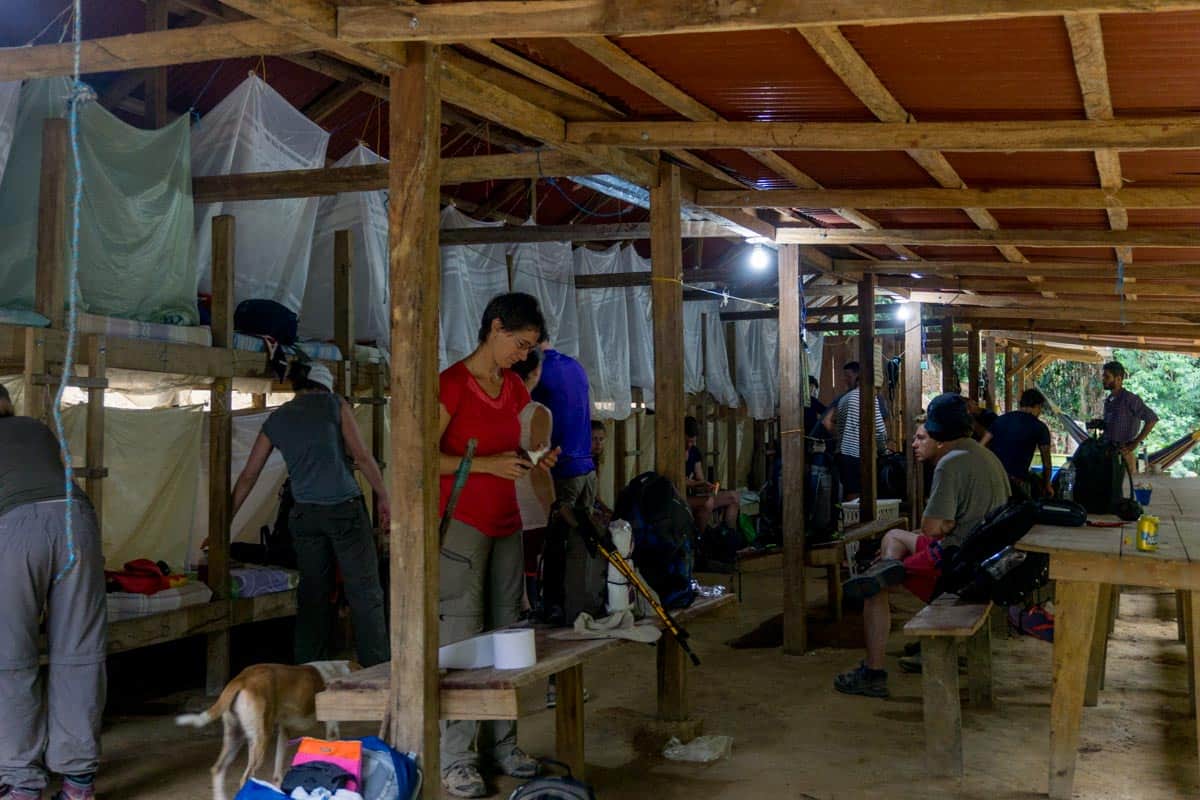
- When we arrived, our cook was already busy in the kitchen getting dinner ready.
- After our group had chosen our respective bunk beds, we left our gears and headed to the swimming hole to jump off the rocks into a deep, cold pool, which was the best relief for the day. Showers (cold) were also available for use.
- Cold beer was available for sale at the camp, the perfect drink after a great hike and good swim.
- All the camps have areas to hang up your wet clothes – but don’t expect them to dry quickly.
- After we enjoyed a filling dinner of fish, potatoes salad, and fruit, we played cards, and then got a briefing from our guide about the area and the cultures living there, as well as the details of the hike the following day.
Day 2:
Hiking time: 6-7 hours Distance: 15 Kms

- We got up early at 6:00 am, enjoyed a hearty breakfast at 6:30 am (coffee/tea, pancakes, fruit), and departure from the camp at 7:00 am.
- Day 2 was a very long day of hiking, with two fruit/water breaks and a stop for a big lunch at another camp.
- We visited some villages along the way, including Kogi Mutanzi where we stopped to learn about the way of life of the families living in this very straightforward and traditional village.
- When we reached camp this day, we got the pleasure of enjoying a cold swim in the river, and a relaxing night in the camp.
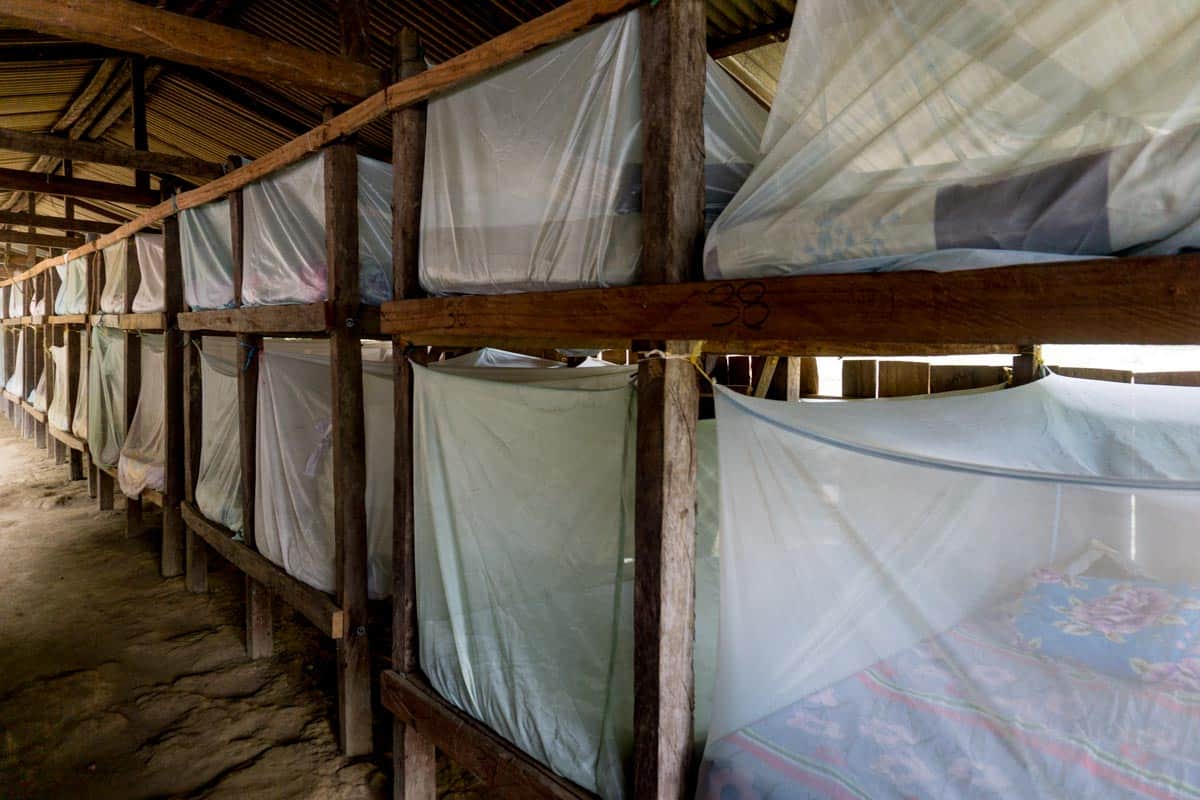
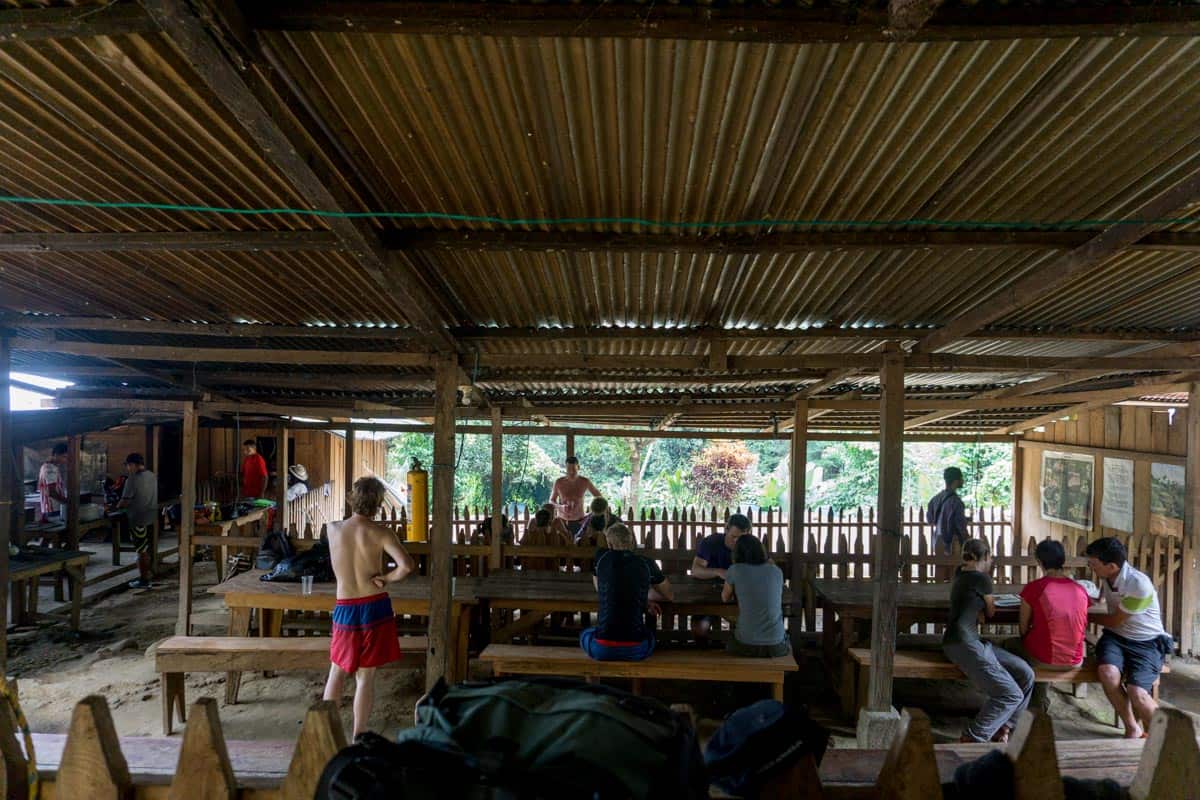
- Dinner for us was Sancocho – a very filling meal of corn chowder with potatoes, yuca, vegetables, and rice.
- That night, our guide shared some fantastic guitar playing and singing.
- Our nights tend to be rather early as our days were long and mornings came early.
Day 3:
Hiking time: 6-hour hike, 3-hour visit to the ruins, Distance: 13.6Kms

- This day started even earlier. We woke up at 5:30 am, had breakfast at 6 am, and left the camp at 6:30 am.
- This morning we reached the steps to the Lost City in about 45minutes after we left camp. After 1,200 interlocking shale steps up to the area, we reached the highest point of the trip (1200 meters).
- We spent three hours here, viewing the ruins of the Teyruna people from 2000 years earlier. We heard about their lives, their rituals, and lavish lifestyle, including the gold jewelry and ornaments they buried under their homes upon death. (These incredible items can be seen at the Gold Museum in Bogotá.)
- Our most special moment was visiting the only house in this archeological site – the home of the Kogi Mama – the Shaman, or the spiritual leader of the Kogi tribe. We spent time here and asked the Kogi Mama about his role, how he serves his people and how he sees the world. After our short interview, the shaman offered us a blessing. We accepted and he signaled us to approach him individually. He lifted our right hands and tied a white string on our wrist revealing six beads that represented the earth’s elements. We thanked him and completed our tour of the ruins.
- After, our group took a cold soak in the river inside the ruins, also known as the fountain of youth, and made our way back to our morning campsite to eat lunch.
- After lunch, our hike back to Santa Marta commenced. We walked to our camp where we stayed for night two.
- Dinner was pasta, with a homemade tomato sauce. So delicious!
Day 4: The Trek Back to the start
Hiking time: 6-7 hours Distance: 12.7 kms

- Our final day involved a long, inclining hike back to Santa Marta.
- The return was the same path we took on the way in. Surprisingly, we saw different things, providing us with a new perspective on the way back.
- We started at 7 am, with our usual two breaks, and reached the town of Machete for lunch at around 1-2pm.
- After a delicious lunch at the original restaurant where we started, we headed back to the van, back to Santa Marta.
- We highly recommend you spend the evening and next day as a rest day in either Santa Marta, Taganga or our favorite, Minca. This is a well-deserved accomplishment for a challenging, yet exhilarating, trek well done.
What you should pack, how to get prepared for your hike:
Your valuables and extra gear
- Rest assured, you can leave anything locked up (and tagged with your name) at the Magic Tours office before you head out on the tour. This also gives you one last chance to bring fewer items.
Connection to The Internet – Zero
- -Consider this as the time to start a digital detox. There is no Internet, and there are limited and unreliable locations to plug in your batteries or charge your phone at camp.
- – Plan to put your phone in airplane mode so that you can conserve your battery for pictures.
What to Pack
- Warning: Bring as little as possible. No really! Challenge yourself with every item in your bag, as you will carry it with you the entire hike. Carrying water will also add to the weight of your pack. (Still, we wish we brought less.)
- Our gear list is slightly different from what Magic tour recommends, here is our tried and true list:
1) Gear
- Backpack – Bring your most comfortable backpack. Even if it’s big, you don’t need to fill it. Instead, choose comfort. Have something that can avoid small straps that dig into your neck.
- Sleeping bag liner/sleep sheet – although the bunk beds have linens and a blanket, it’s still questionable if the blanket is cleaned as we heard about fleas and bed bugs (although we didn’t have this problem.)
- Headlamp – Headlamp is best for dark campsites.
- Cell Phone (for pictures), camera, extra full batteries
- Battery Charger – We advise to avoid carrying this if you can, due to weight. But if battery conservation is an issue for your camera, it may be necessary.
- Small clothesline pins/clothesline that clothes stay on – a clothesline is supplied at every camp but it was windy, and many of our items blew off the line. In some camps, we arrived later, and there were no empty clotheslines.
- Two one-liter refillable water bottles – there are water stations at each camp where you can drink and refill your bottles. We love these ones from Kleen canteen, we carry one each and picked up an extra plastic bottle for the hike.
2) Clothes (for couples)
- We will stress that you need as little as possible. You will get sweaty, wet and dirty and we wore the same clothes every day, which most of us did anyway. It was rather refreshing to put on a cool t-shirt off the line each morning.
- Two men’s Tshirts / 2 ladies shirts – extra shirts in case you need it, or a clean one to wear after a shower. We love Icebreaker because they are odor resistant, you can wear them several times, and they dry quickly.
- Men’s Long sleeve shirt /ladies long sleeve shirt– to sleep in or warm up after swim/shower, ideally merino wool – Icebreaker keeps you warm and dry and odor free.
- Men’s Raincoat /Ladies raincoat– if you can use this as your light jacket in the evening instead of a coat, we would recommend it. It’s far too humid and hot if it rains, unless it’s the rainy season, then bring it! We use Patagonia and Columbia brand raincoats and we’ve had them for years
- One pair light pants (men)/ light pants women – to wear in evening after swimming or shower
- One pair- shorts men/ shorts ladies – wear each day or opt for another pair of light pants instead to avoid mosquitos. We like Prana, they are durable, a little longer and stretchy.
- Four pairs of socks men/ socks women – one dry, clean pair for each day. We like Icebreaker or Smartwool they stay dry, odor-free and they are incredibly durable.
- Four pairs underwear men/ underwear women’s – Ideally a brand like Exofficio – a smell-free and fast-drying. We’ve had these for years.
- Sandals Men/ Sandals Women – Ideally Crocs, Teva’s or something that stays on your feet but easy to slip out of. You have to hike up some rocks or go swimming, so choose the best that can stay on.
- Hiking shoes men/ Hiking shoes women – We used lightweight, low-rise shoes, or ones with ankle support, your choice.
3) Toiletries
- Hat – to use as shade from the sun
- Sunscreen – I prefer to bring in a few small bottles- easy to access when needed (as you will reapply from sweating a lot)
- Bug spray – Definitely bring something with Deet – for us, the 3rd day at the ruins was the worst part of the trek
- Water purifying tablets – The water comes from the rivers/natural springs in the area. Not everyone’s stomach can handle it; these are easy to use on the go too. Another option is investing in a water purifying water bottle, these work well, but we found the water tablets were easier given we had two bottles each.
- Toilet paper– bring at least a roll for yourself
- Soap, shampoo, toothpaste, toothbrush
- Small mirror – often bathrooms have no mirrors which you can use when you put on contacts, or check if you still have dirt on your face!
- Wet wipes – for sticky hands (fruit breaks) and dirty bathrooms where sinks may be limited
- Large plastic bags – to put your wet gear in if it doesn’t dry (bathing suit) and for your phone, or camera if it rains
4) Medical kit
- Oral rehydration salts – this helps with hydration especially if you have diarrhea
- Imodium, antibiotics -(in case you have terrible diarrhea, you can get these items in Cartagena or Santa Marta at a pharmacy before your trip)
- Band-Aids, duct tape (the best thing for blisters) or moleskin for blisters
- Small tiger balm travel size or Tylenol – for aches and pains, going down is tough on the knees!
5) Other
- Money – Bring a small amount of money (to buy beer if you really need a cold one – at the camps)
What not to bring on the Lost City Trek Colombia
- Extra clothes – You will not need them!
- Makeup – you will just sweat it off, it’s not necessary!
- Leave your valuables
- If there is anything that you are 50% confident in taking, don’t take it.
- If you have any more questions about the Lost City Trek Colombia, feel free to contact us.
- We highly recommend Impulse travel – these guys are pros when it comes to detailed travel planning.
- If you are planning your trip to Colombia and looking for more information, you can find all our Colombia posts here.
Like it? Pin It!!
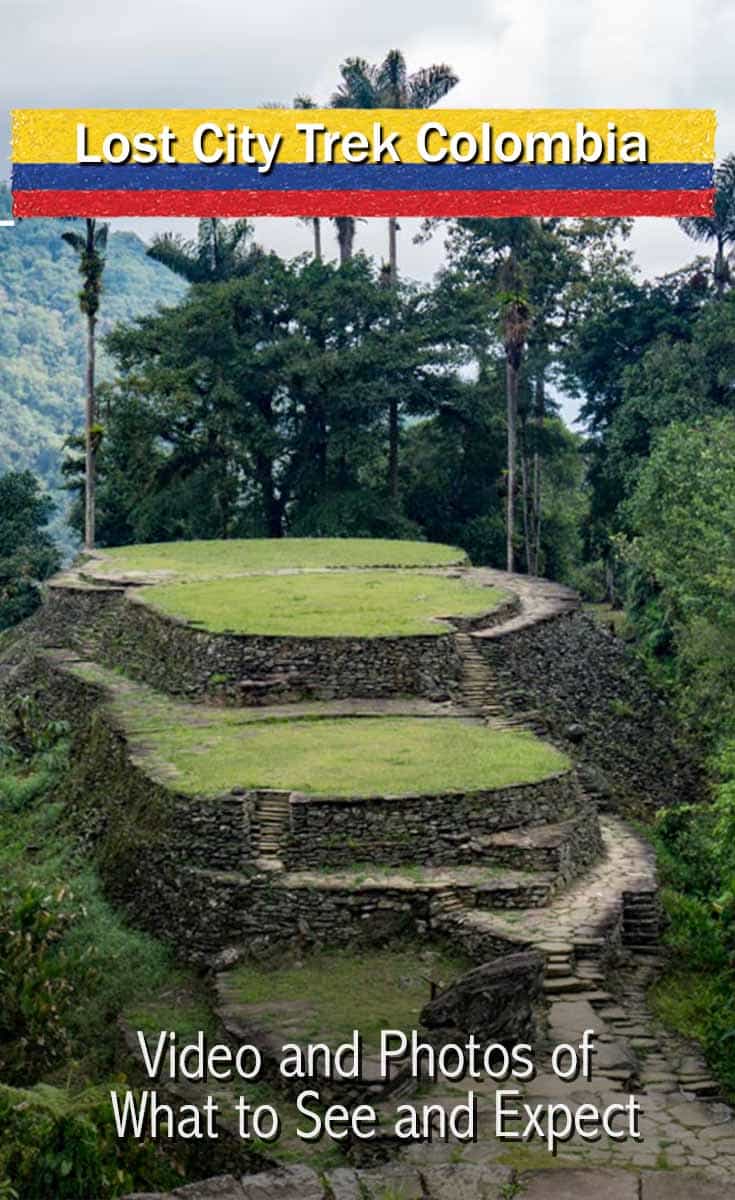
By using one of the links on this page (at no extra cost to you) it will generate a small commission from any sales. We recommend these products because we love them and use them regularly. We also received a complimentary trip with Impulse travel, however we only recommend tours and trips that are well planned and appropriate for our readers. This helps us keep providing quality content and tips for you. Enjoy your new products!

